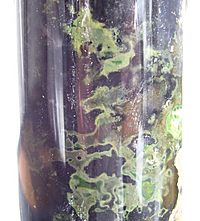Green sulfur bacteria facts for kids
Quick facts for kids Green sulfur bacteria |
|
|---|---|
 |
|
| Green sulfur bacteria in a Winogradsky column | |
| Scientific classification | |
| Domain: | |
| Phylum: |
Chlorobi group
|
| Class: |
Chlorobia
|
| Order: |
Chlorobiales
|
| Family: |
Chlorobiaceae
|
| Genera | |
|
Chlorobium |
|
Green sulfur bacteria are a special group of tiny living things called bacteria. They are known for their unique way of getting energy and for not needing oxygen to live. These bacteria are very important in nature's cycles, especially the sulfur and carbon cycles.
Contents
What Are Green Sulfur Bacteria?
Green sulfur bacteria are a type of microorganism. This means they are so small you need a microscope to see them. They belong to their own special group, or phylum, called Chlorobi. This makes them different from many other bacteria.
One of the most interesting things about them is that they are photoautotrophic. This big word means they can make their own food using light, just like plants do. But there's a big difference: plants use water for this process, while green sulfur bacteria use sulfur compounds.
They are also obligately anaerobic. This means they absolutely cannot live where there is oxygen. Oxygen is actually poisonous to them! Because of this, you'll find them in places where oxygen is scarce or completely absent.
How Do Green Sulfur Bacteria Get Energy?
Green sulfur bacteria use a process similar to photosynthesis to create their own food. This process is called anoxygenic photosynthesis because it does not produce oxygen.
Instead of water, these bacteria use compounds like hydrogen sulfide (which smells like rotten eggs!) as a source of electrons. They take in light energy using special pigments, or colors, that are often green, brown, or yellow. These pigments help them capture sunlight, even in very dim conditions.
The energy from light helps them turn carbon dioxide into sugars. These sugars are their food. This unique way of making food helps them thrive in environments where other living things might struggle.
Where Do They Live?
Because green sulfur bacteria cannot stand oxygen, they live in specific places. You can often find them in:
- Deep waters: They live at the bottom of lakes, ponds, and even some oceans where oxygen levels are very low.
- Hot springs: Some types can be found in hot, sulfur-rich springs.
- Sediments: They live in the mud and dirt at the bottom of water bodies.
- Hydrothermal vents: These are cracks in the ocean floor that release hot, mineral-rich water.
In these places, they often form colorful mats or layers. These layers can be green, brown, or even reddish, depending on the specific type of bacteria and the light conditions.
Why Are They Important?
Green sulfur bacteria play a big role in Earth's natural cycles:
- Sulfur Cycle: They help recycle sulfur in the environment. They change sulfur compounds from one form to another, which is important for the balance of ecosystems.
- Carbon Cycle: By taking in carbon dioxide and turning it into organic matter, they help remove carbon from the atmosphere. This is part of the global carbon cycle.
- Ancient Life: Scientists believe that early life forms on Earth might have used similar ways to get energy. Studying green sulfur bacteria helps us understand how life evolved billions of years ago.
These tiny bacteria, though unseen, are vital parts of our planet's hidden ecosystems.
Images for kids
See also

- Chlorobi para niños (In Spanish)


